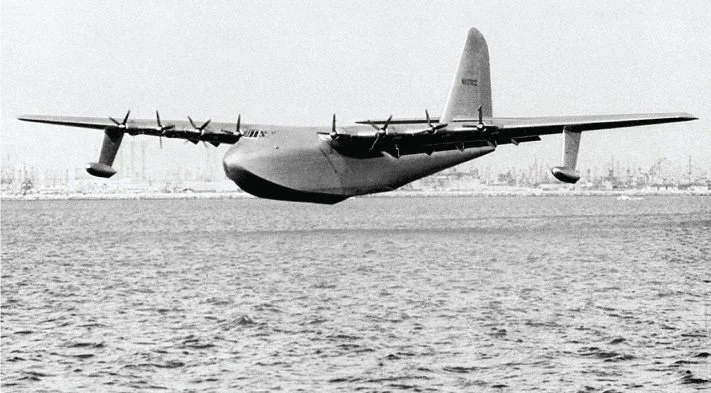Playa Vista, Los Angeles County, California. The Birthplace of the “Spruce Goose”
First published June 29, 2025
The Spruce Goose on it's one and only flight in 1947
In November 2018, Alice Jo and I, in our 80’s, left our home of nearly 60 years in Rochester, New York. Rochester is a wonderful community, where I pursued my medical professorship and Alice Jo her volunteer work, having retired from being an honored and highly regarded computer software developer. Larry Peckham, the CEO of LPA Software, her firm, advised me at an annual dinner that his principal wish in life was to clone Alice Jo. We left our friends and our many connections acquired over the years: the University of Rochester, its medical center, the Eastman School of Music, the Rochester Symphony orchestra, the Rochester Institute of Technology, where Alice Jo received her master’s degree in computer sciences and is a Distinguished Alumna, familiar and notable stores (Wegman’s Supermarket), favorite restaurants, and more.
What we gained proved to be substantial as well, as we predicted when we made that decision. We were 2800 miles closer to our three daughters and sons-in-law, two in Los Angeles County and one in San Luis Obispo, 150 miles north. The onset of the covid-19 epidemic and our aging required considerable support from our family. It proved life saving for us. It, also, brought us close to our seven adult grandchildren, a special benefit. We are able to congregate as a family frequently and, often, spontaneously.
We settled in an independent senior living community, newly built in Playa Vista in southwest Los Angeles County. Over the last 85 years, Playa Vista, a community with an area a few mile square and a very short distance from the Pacific beachfront communities of Playa del Rey and Marina del Rey, has become a tech hub. So much so, that it is nicknamed “Silicon Beach”. Howard Hughes initiated this evolution by selecting it as the site of the headquarters of the expansion of Hughes Aircraft Company from 1941 to 1985. In 1940, when Hughes bought the land it was undeveloped at the edge of the Ballona Wetlands that sat adjacent to the Pacific Ocean.
After Hughes Aircraft was sold to General Motors and became Hughes Electronics, over the next 40 years, the empty facilities in Playa Vista became the home of a several high technology facilities including a large Google presence and accompanying attractive housing with a very young population. “The Runway”, our nearby shopping area, is a linear aggregation of stores, restaurants and a theater. This name derives from it being the site of the east-west runway servicing Hughes Aircraft for over 40 years. Nearby, there are former aircraft hangers attractively and extensively renovated for office space, including the former gargantuan hanger in which the Hughes H-4 Hercules, alias the “Spruce Goose”, was built.
The H-4 Hercules was intended for use in World War II for air transport of large military ordinance, e.g. two Sherman tanks and 750 fully equipped troops, especially to the European theater of war operations,. This option was engendered by the large allied losses of equipment and men crossing the Atlantic Ocean to North African and, later, European battlefields, as a result of the destructive impact of the torpedoes of the marauding German U-Boats, the “wolf packs”.
The original idea for this giant, transport plane was that of Henry J Kaiser, the industrialist, shipbuilder, auto manufacturer and pioneer in developing healthcare programs for his employees. He enlisted Howard Hughes to build it. The plane was at first designated the HK-1, the initials of both men’s last names. Kaiser left the project but Hughes persisted. He changed the designation of the aircraft to H-1, and eventually to H-4, as the plane went through a sequence of iterations, before the final design was achieved. The airplane was fabricated of wood because of the unavailability of aluminum, as wartime use of this metal had demand exceeding its supply. This enormous craft also needed to be fabricated with as low a weight as possible to allow it to lift off with the engine designs of the early 1940’s. It was made of laminated birch, not spruce.
The project was so complex that the plane was not completed until two years after the war, in 1947. After completion, a house-moving company transported it to pier E in Long Beach in three segments. In November 1947, after reassembly, it took its first and only flight rising to an altitude of 70 feet and travelling a distance of one mile in the channel facing Cabrillo Beach, California.
From 1947 to Hughes’s death in 1976, the plane was housed in a huge climate-controlled hanger in Playa Vista at a very large cost. The plane’s nickname, spruce goose, was an appellation of derision by critics of this improbable and impractical project and its eccentric but determined builder. The “birch behemoth”, a more accurate descriptor, did not have the derisiveness implied by the “spruce goose”. Later, the enormous hanger was converted to a film facility. In time, “spruce goose” became a term of endearment as this birch behemoth of a flying boat was retired after a single, very, very short career in the air. Unlike the mythical hero, Hercules, known for his adventures and great deeds through the ancient Greco-Roman world, this Hercules was fixed in place. Initially, exhibited in Long Beach, California, it moved to what is its final location of display, the Evergreen Aviation Museum, in McMinnville, Oregon.
The Spruce Goose in the Evergreen Aviation Museum, in McMinnville, Oregon
In 2016, Google took over the hanger building and commissioned its renovation into the Google Spruce Goose Office complex, a dramatic architectural space, on South Campus Drive in Playa Vista.
Legend. I was a model builder since a pre-teenager and this is my rendition of the H-4 Hercules (aka the spruce goose).


